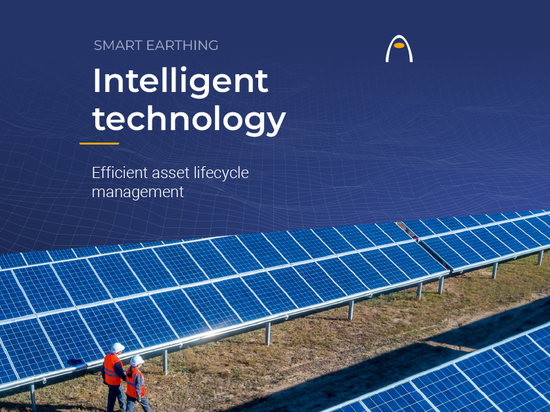
#Industry News
Operational and financial efficiency in the solar energy sector: how to extend the lifespan of solar farms with intelligent technology
Operational and financial efficiency in the solar energy sector: how to extend the lifespan of solar farms with intelligent technology
Every significant investment has its share of risk. And solar energy, the leader among renewables, is no exception. A solar farm’s design, implementation and maintenance pose operational and financial challenges that start from the first phase and extend throughout its useful life. On the one hand, if a good project is not carried out before construction, the operation of the energy installation can be compromised. On the other hand, if assets are not protected against any eventuality, such as a thunderstorm, the cost of repairs can drive up costs and slow the return on investment.
The future of energy generation is inextricably linked to renewables and that’s a fact beyond dispute. The increase in sustainability criteria in both the public and private spheres and the need to accelerate the decarbonisation – a reduced dependence on fossil fuels – of industry and society are essential instruments for the energy transition to generate fewer emissions into the atmosphere.
Photovoltaics is also the type of sustainable energy that grows the most every year, even in the domestic sphere, through the installation of solar panels on private properties that encourage the self-consumption of electricity. With investment in solar parks on the rise, planning in detail the initial investment and the costs derived from maintenance and safety are two fundamental aspects so the return on investment -ROI- is met within the planned timeframe.
Some data. According to the International Renewable Energy Agency (IRENA), investment in renewable energies has increased almost fourfold in 10 years, from 171 to 439 billion euros. Of this last figure, 298 billion US dollars (298 billion European dollars) corresponds to investment in solar energy, twice as much as the second most widely deployed technology, wind energy.
Solar energy: challenges for the operation of photovoltaic parks
Due to their unique characteristics of location and size (large open spaces) and the economic outlay on sensitive technology, solar parks face several challenges in the quest for optimal operation; challenges that must be addressed even at the earliest stages of their design.
Not conducting a proper study of the ground characteristics or ignoring them altogether before implementing the grounding system will harm its operation and efficiency. In addition to the resistivity values of the ground, a proper grounding system with durable connections will have a positive impact on the lifespan of the energy installation and all components connected to it.
The cost of maintaining assets, solar panels and other electronic components that are vulnerable to voltage surges, whether caused by atmospheric phenomena (electrical storms) or by a malfunction of the electrical installation, as well as possible acts of vandalism or sabotage, must be taken into account in both the design and operation phases. Continuous monitoring of the installation, therefore, helps to prevent any of these eventualities.
Last but not least, the people who work in the daily operation of a solar farm must be protected against circumstances such as a fire caused by lightning or a short circuit.
Operation of a solar farm: smart solutions for its entire life cycle
The strength of the R&D department and the commitment to sustainability are two basic pillars of Aplicaciones Tecnológicas S.A. To protect future investments in the solar energy sector, both economic and ecological, we have developed SMART EARTHING and SMART LIGHTNING, intelligent solutions that benefit from a straightforward Industry 4.0-oriented approach that seeks efficiency and safety through technologies such as IoT and AI.
Design phase
When designing a solar farm, the implementation of an optimal earthing system will affect the future operational and financial efficiency of the whole installation. Therefore, for solar plant projects in their early stages, Aplicaciones Tecnológicas S.A. offers:
Using the GEOELECTRIC EARTHING METER system, we carry out a geoelectric study to determine the stratification and resistivity of the ground.
Professional service for EARTHING SYSTEMS PROJECTS 4.0 based on international standards and designed with advanced GMAT/PAST software, which allows the optimum solution to be determined objectively.
Use of anti-theft conductors and specific electrodes based on the particularities of the terrain: corrosion-resistant electrodes for aggressive soils, special electrodes and/or perimeter conductor rings for highly resistive soils, etc.
Durable connections between conductors using Apliweld® Secure + exothermic welding. Aluminothermic welding achieves perfect joints that remain in excellent condition throughout the lifetime of the installation, as well as reducing costs and improving occupational safety.
The advanced and continuous monitoring system of the earthing system status employing SMART EARTHING MONITORING SYSTEM.
Operational phase: continuous monitoring of the earthing system
Solar farms in operation need to operate at maximum capacity to fulfil their mission: to provide clean energy to help reduce the carbon footprint of the electricity supply.
The SMART EARTHING MONITORING SYSTEM solution enables the efficient management of grounding systems by centrally monitoring smart sensors distributed throughout the facility and transmitting and interpreting the data through IoT connectivity and Artificial Intelligence.
This monitoring enables real-time detection of critical safety situations (ground disconnections, theft, breakdowns or accidental breaks) that require corrective maintenance, but also provides data for predictive maintenance that optimises the useful life of the assets connected to the grounding system. All of this results in significant cost savings, thanks to the operational and logistical simplification of verification processes.
Operational phase: lightning storm safety
Solar farms, like any outdoor installation, are susceptible to inclement weather, especially thunderstorms. If lightning strikes a solar panel directly, it can cause significant damage to the panel, overload the electrical system and damage expensive electronic components such as charge controllers and inverters. On the other hand, an indirect strike can cause an overvoltage to affect these components as well.
In addition, any lightning strike can cause a temperature rise on the surface of the solar panel, which could result in cracks or breaks in both the glass and the solar cells.
Aplicaciones Tecnológicas S.A.’s SMART LIGHTNING portfolio of intelligent lightning storm safety products for solar farms works in all phases: preventive protection (storm detection), external protection against lightning strikes and internal protection against surges.
ATSTORM® is an advanced thunderstorm early warning system designed to activate and deactivate temporary preventive measures to minimise the risks associated with potential lightning strikes. It features dual-sensing technology that measures the electrostatic field, which warns of forming storms, and the electromagnetic field, which warns of approaching storms. This storm detection system relies on IoT technologies and expert algorithms to send and process the data collected by its sensors in real-time.
DAT CONTROLER® REMOTE is an intelligent and advanced lightning rod, a reference in the segment of the Early Streamer Emission (ESE) air terminals. DAT CONTROLER® REMOTE is a device with self-diagnosis and communication via IoT (Internet of Things) of the result to ensure the correct operation of the equipment remotely. Furthermore, this lightning rod allows daily self-checking of its status, without the need to dismantle it or use auxiliary lifting equipment.
SMART LIGHTNING LOGGER continuously monitors the electrical activity in the down conductors of the SPCRs in which it is installed. When a lightning strike occurs, the device collects all the information about the lightning current and sends this information via IoT to determine the urgency of the repair or to manage the claim with an insurer.
Protection against transient overvoltages with the ATPV range of surge protectors (Type I, II and III) that shield sensitive and exposed electronic elements such as inverters, electrical panels and data lines.
If you would like to receive more information about the advances in security and cost savings that our devices provide, you can contact us through this link.
You can also attend any of our free webinars on smart solutions for the photovoltaic sector via this link.







